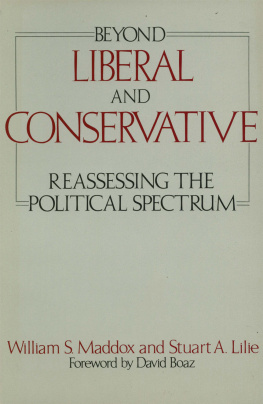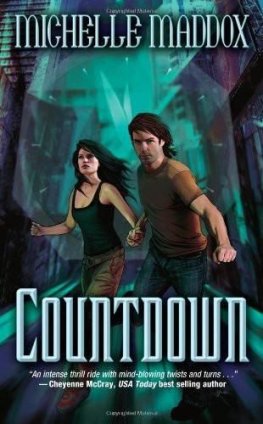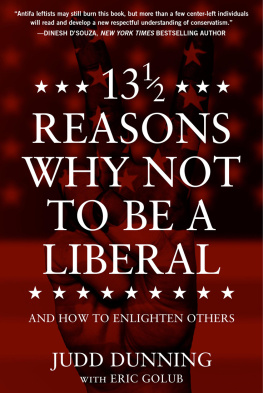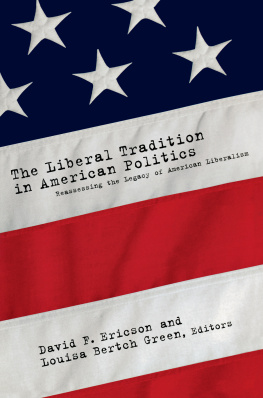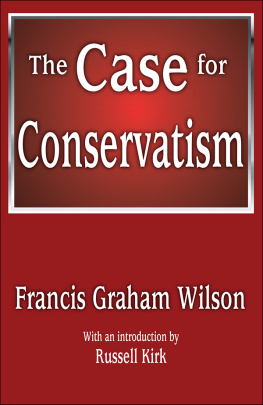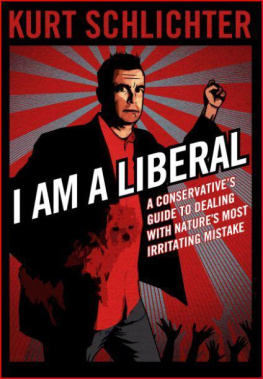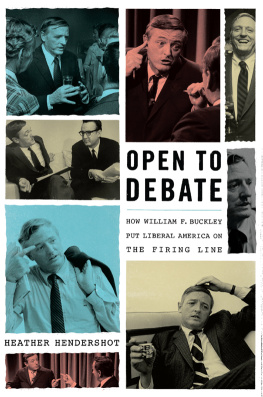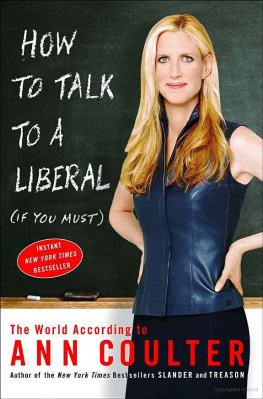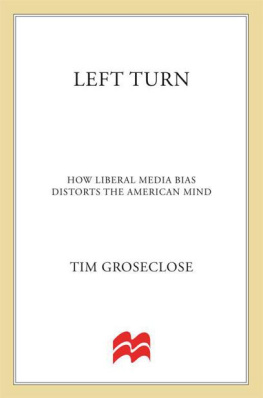BEYOND
LIBERAL
AND
CONSERVATIVE
BEYOND
LIBERAL
AND
CONSERVATIVE
REASSESSING THE POLITICAL SPECTRUM
William S. Maddox and Stuart A. Lilie
Foreword by David Boaz
This book was made possible by a grant from the Scaife Family Charitable Trusts.
INSTITUTE
Copyright 1984 by the Cato Institute.
All rights reserved.
Second printing: February 1986
Library of Congress Cataloging in Publication Data
Maddox, William S., 1949
Beyond liberal and conservative.
Includes bibliographical references and index.
1. Political scienceUnited States. 2. Right and left (Political science) I. Lilie, Stuart A., 1941 II. Title.
| JA84.U5M374 | 1984 | 320.5 | 84-17027 |
ISBN 0-932790-47-X
Printed in the United States of America.
C ATO I NSTITUTE
224 Second Street SE
Washington, D.C. 20003
Foreword
Pollsters, journalists, and political practitioners seem to have an uncontrollable urge to put every politician and thinker into the liberal box or the conservative box. Increasingly, though, these terms fail to describe many Americans, and our understanding of politics has not caught up with reality. This may be at least partly because our outmoded political language continues to shape our thinking. As George Orwell wrote in "Politics and the English Language," "If thought corrupts language, language can also corrupt thought. A bad usage can spread by tradition and imitation, even among people who should and do know beUer." There may be no clearer example than the attempt to fit every American into the liberal-conservative straitjacket.
The difficulty of doing this, and the resistance to it by those whose views differ from liberal or conservative orthodoxy, is reflected in the proliferation of such terms as "neoconservative," "neoliberal," "progressive," "social conservative," and "New Right." (Perhaps it is a sign of surrender to label a politician as a "maverick.") All of these terms, however, are just variations on a theme, reflecting only nuances of difference. Surely a country with a political tradition as rich and diverse as our own contains many people whose political views are not adequately described by any of the current terms.
Indeed in the past few years we have seen a number of political figures, movements, and election results that defy traditional liberal-conservative analysis:
In 1982 the voters of California soundly rejected a proposed gun-control initiative and approved several tax cuts-while simultaneously voting "yes" on a nuclear-freeze initiative.
After 1968 such leading Democrats as Sen. Henry M. Jackson of Washington and Mayor Richard Daley of Chicago were often referred to as conservative Democrats. Yet they were enthusiastic supporters of the New Deal and subsequent social welfare legislation. Their "conservatism" consisted only of hawk-ish foreign policy views and a resistance to the lifestyle changes of the 1960s.
Gov. George Wallace of Alabama was widely regarded as a right-wing presidential candidate in 1968. Yet his candidacy was rejected by most conservative leaders not just for its aura of racism but also for Wallace's reputation as a big-spending governor and his thoroughly interventionist positions on economic issues-such as a 60 percent increase in Social Security benefits, 100 percent parity for farm prices, and public works employment.
In 1980 independent presidential candidate John Anderson attracted at times the support of as much as 25 percent of the public with his unusual combination of fiscal conservatism, social liberalism, and mildly dovish views on foreign policy. His support actually fell when his views began to seem more conventionally liberal. This decline may have been attributable to other causes, of course, but campaign aide Mark Bisnow in his book Diary of a Dark Horse suggests that Anderson lost much of his original support by moving away from his fiscal conservatism.
Rep. Bill Green (R-N.Y.) and Rep. Ike Skelton (D-Mo.) received identical 50 percent ratings on their 1982 congressional votes from the liberal Americans for Democratic Action. As political analyst Alan Baron points out, though, they actually agreed on only five of nineteen issues, with Green voting liberal on social issues and Skelton voting liberal on economic issues.
Currently, overwhelming majorities of the American public tell pollsters they support the nuclear freeze and the constitutional amendment to balance the federal budget. Clearly a significant number support both.
What is the common thread in all these phenomena? It is that these election results and political figures cannot be adequately described as liberal or conservative. The early John Anderson, with his fiscal conservatism and social liberalism, would seem the political opposite of George Wallace, with his New Deal economics and hostility to civil liberties and changing lifestyles. But which is the liberal and which the conservative? Or are they both, incongruously, moderates? When voters vote for both a nuclear freeze and tax cuts, are they being liberal or conservative? When California voters in 1978 voted against both a "liberal" anti-smoking initiative and a "conservative" anti-gay initiative, were they being conservative or liberal?
The problem is that our political language is not sufficient to describe political reality. The belief systems of Americans are more complex than the liberal-conservative dichotomy acknowledges. Perhaps the frustration that many Americans have in articulating their political views-the reluctance to describe themselves as either liberal or conservative, the apparently contradictory election and poll results-is a result of the inadequacy of our current political language. Political scientists, pollsters, and journalists offer only two labels to describe the beliefs of millions of Americans.
If these opinion leaders began to recognize the existence of more than two political perspectives in the United States-at least the four-way matrix provided by Professors Maddox and Lilie-our whole way of thinking about politics might change. People would begin to recognize that they have four possibilities to choose from in describing their own views. If the Gallup poll suddenly began asking people to describe themselves as "liberal, conservative, libertarian, or populist," it is likely that at first fewer people would choose "libertarian" or "populist" than actually hold those views, according to Maddox and Lilie. But as these terms gained currency, and their definitions came to be understood, people might come to describe themselves more accurately.
Building a winning coalition might then be seen as a more complex process. Instead of assuming that a moderate Republican would be more successful than a conservative, and a moderate Democrat more attractive than a liberal, because they are closer to the center of the liberal-conservative spectrum, journalists would see that a liberal Democrat and a conservative Republican would likely be fighting for the votes of libertarians and populists. The candidates' selection of issues would then be more complex than if their only goal was to move toward the center of a one-dimensional spectrum.
Given the obvious inadequacy of the terms "liberal" and "conservative," one is driven to ask why political observers continue to use them. Professors Maddox and Lilie offer several possibilities. One is that political scientists and others assume that political "elites" operate along liberal-conservative lines, and thus the dichotomy is relevant for the study of politics. A second possibility is that since the New Deal, divisions over the role of government in the economy have been the defining political issues in the United States and that these divisions fit neatly into the liberal-conservative spectrum. I am inclined toward their third suggestion: The liberal-conservative dichotomy is simple, and it is much easier to divide people into only two categories. Along with this methodological simplicity is a certain inertia. Having long discussed politics in liberal-conservative terms, one may find it easiest to continue in that vein. One hesitates to do further injustice to Thomas Kuhn's much-abused notion of scientific paradigms, but it is arguable that political scientists have constructed a paradigm of political interpretation-the liberal-conservative dichotomy-and are reluctant to give it up despite the evidence that it increasingly distorts our perceptions.


